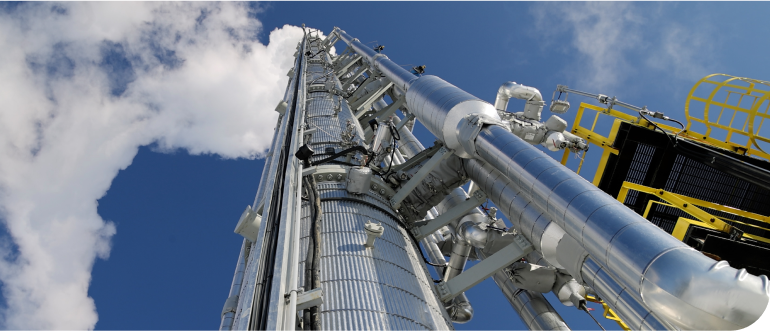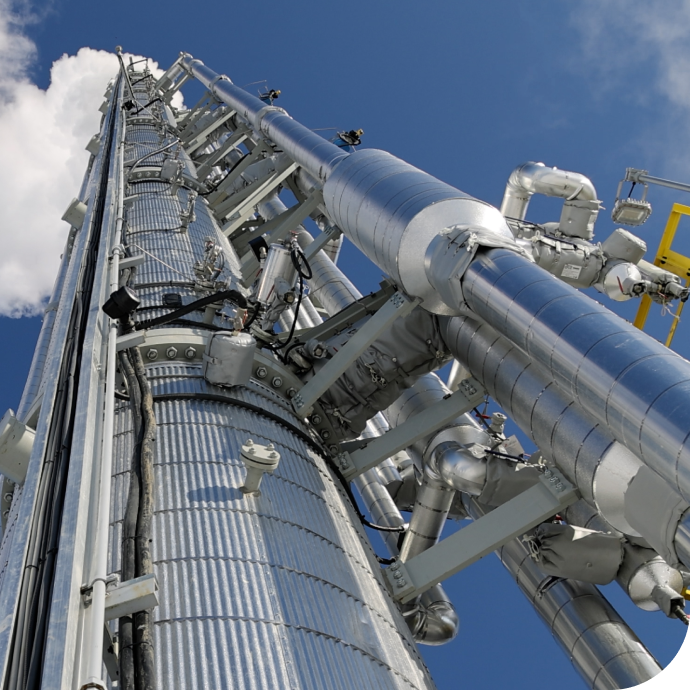Oil & Gas
Index Score
Thematic Breakdown
Policy Score
Policy Score
More stringent methane regulations and government capital inflow into decarbonization projects has boosted the index. In addition, increases in the federal benchmark carbon price and more provincial funding programs have contributed positively to the policy score. However, there’s a strong likelihood the controversial oil and gas emissions cap is shelvedEndnote 7.
Detailed Scorecard
Indexed to 2019
baseline year
Weighted contribution to oil & gas sector score
Capital Score
Capital Score
The capital score has jumped 36% since 2019, with government-backed investments in decarbonization projects and technologies as the primary driverEndnote 8. The year also saw investments in carbon capture projects, such as the Canada Growth Fund's $500 million initial investment in decarbonizing oilsandsEndnote 9 production, which could advance investment over the rest of the decade.
Detailed Scorecard
Indexed to 2019
baseline year
Weighted contribution to oil & gas sector score
Action Score
Action Score
Canadian operators’ continued action on curtailing methane led to an estimated 50% improvement in managing methane emissions from oil and gas projects relative to 2019 levelsEndnote 10. However, further growth in the action score will need additional deployment of CCUS capacity and more efforts to prevent methane venting.
Detailed Scorecard
Indexed to 2019
baseline year
Weighted contribution to oil & gas sector score
Emissions Score
Emissions Score
Oil and gas emissions have declined over the past 10 years, and are expected to be at the lowest levels since emissions peaked in 2014 (excluding the pandemic-induced low in 2020)Endnote 11. Increased efficiencies and improved methane management have driven lower emissions amid rising productionEndnote 12.
Detailed Scorecard
Indexed to 2019
baseline year
Weighted contribution to oil & gas sector score
Historical Trends
Policy:
Capital:
Consumer Action:
Emissions:
Business Action:
Technology:
Total:
Policy:
Capital:
Consumer Action:
Emissions:
Business Action:
Technology:
Total:
Policy:
Capital:
Consumer Action:
Emissions:
Business Action:
Technology:
Total:
Policy:
Capital:
Consumer Action:
Emissions:
Business Action:
Technology:
Total:
Policy:
Capital:
Consumer Action:
Emissions:
Business Action:
Technology:
Total:
Policy:
Capital:
Consumer Action:
Emissions:
Business Action:
Technology:
Total:


CASE STUDYEndnote 13
Entropy: The “contract” that’s advancing Alberta’s carbon capture industry
The Issue
Emission reduction projects such as carbon capture and storage (CCS) pose a market challenge: while removing CO2 emissions before reaching the atmosphere can reduce the impact of industrial activity, there is limited economic reward for companies that develop and implement the technology. The industry faces several challenges: capturing carbon is an expensive and complex process, permanent geological storage offers limited economic benefits, while carbon price volatility does not instill investor confidence.
Guaranteeing stable revenue is key to unlocking risk-averse private investment–a necessary catalyst for wide-scale CCS deployment.
That’s where carbon contract for difference (CCfD), or carbon credit offtake agreements, from private or public institutions can de-risk investment and improve the technology’s economics.
The Company
Entropy Inc., a spin-off from Calgary-based Advantage Energy, is developing technologies to remove carbon from pre-and post-combustion emissions and permanently store them in the ground.
Entropy has developed a CCS project with its modular carbon capture solution at Advantage’s Glacier Gas Plant, with early success—as the first commercial natural gas post-combustion CCS project in the world. But pursuing larger-scale projects needed robust financial backing from heavyweights like the Canada Growth Fund and Brookfield Global Transition Fund to demonstrate commercial viability, de-risk future projects and attract clients to capture a piece of the growing carbon capture sector.


The Technology
Entropy’s proprietary technology captures CO2 that’s produced when natural gas is combusted—the first in the world to commercially launch the technology. The application can be plugged into a spectrum of industries—including methanol production, natural gas processing, thermal oil production, clean electricity and data centres, making it a versatile solution for many hard-to-abate industries.
Another differentiator for Entropy is its experience with Glacier Phase 1 project. Over the past two years, the company has learned to execute post-combustion CCS projects at high efficiency and lower costs. With CCS in early stage of development, Entropy’s success with Glacier is a breakthrough for the technology.
The Opportunity
In late 2023, Entropy secured a pivotal opportunity by partnering with the Canada Growth Fund (CGF). The $200 million equity investment from CGF not only provided crucial capital for new projects but also offered a carbon credit offtake (CCO) commitment, effectively a set price for carbon, in the form of a carbon credit off-take arrangement.
CGF committed to provide Entropy with one of Canada’s first ever large-scale, long-term, fixed-price carbon credit offtake commitment by committing to purchase up to one million tonnes per annum of carbon credits for 15 years. That’s given Entropy the opportunity to pursue projects as diverse as carbon capture for methanol production to offsetting carbon emission for natural gas-powered data centres.
The CGF deal came on the back of Entropy securing a strategic $300 million investment agreement with Brookfield, via the Brookfield Global Transition Fund, in 2022 to scale up the deployment of Entropy's CCS technology globally.
The Unlock
The two deals effectively broadened Entropy's market reach, positioning the company for new partnerships with heavy emitters across many industries.
While the Glacier project accounts for approximately 160,000 tonnes backstopped by CGF, that leaves Entropy with around 840,000 tonnes of carbon credits for other high-emitting projects.
The company is eyeing four more developments, including a promising agreement with Methanex, a methanol producer. The collaboration, if successful, would mark another world-first for Entropy—capturing over 400 tonnes of CO₂ per day from methanol production and creating “blue” methanol. The project could secure a final investment decision next year.
The company is also in talks with thermal oil producers in North America, while another project in engineering phase is with a data centre developer seeking to source a baseload, low-carbon power solution.
If completed, these projects each in the $200-million range will see Entropy emerge as a first mover in several sectors, from capturing CO₂ from natural gas compressor exhausts to CO₂ sequestration in clean power generation.
The Lesson
Scaling cutting-edge carbon capture technology isn't solely about engineering; it's about financial innovation and creating alignment among stakeholders. Entropy's partnership with CGF illustrates the critical role of government-backed funds in de-risking first-of-a-kind projects. The relationship has enabled Entropy to validate its technology in real-world conditions, shifting perceptions from experimental to commercially reliable.


When you're solving for the commercial uncertainty, the technical uncertainty and the capital uncertainty all the same time, it gets hard. My hope is that as we generate these $200-million sized projects, we're taking away two of those risks—the commercial and the technical—and paving the way for larger projects to get off the ground.
Sanjay Bishnoi,
CEO, Entropy Inc






